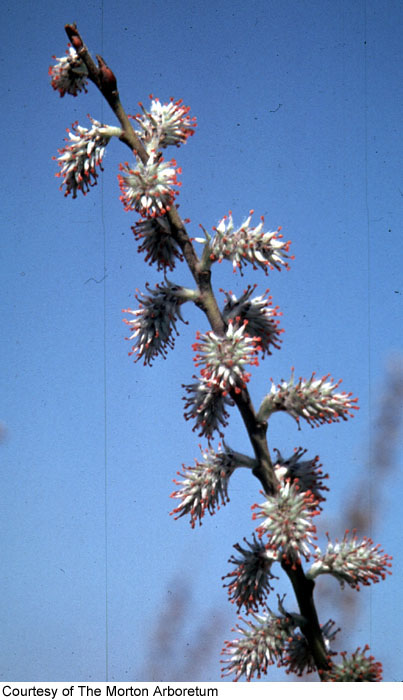|
|
|
|
Family: Salicaceae
prairie willow
[Salix humilis var. angustifolia (Barratt) Zabel, moreSalix humilis var. grandifolia (Barratt) Zabel, Salix humilis var. hyporhysa Fernald, Salix humilis var. keweenawensis Farw., Salix humilis var. rigidiuscula (Andersson) B.L.Rob. & Fernald, Salix tristis var. glabrata (Andersson) Andersson] |
Shrubs, 0.3-3 m, (forming clones by layering). Stems: branches dark red-brown, not or weakly glaucous, tomentose to glabrescent; branchlets red-brown, yellow-brown, or greenish brown, moderately to very densely villous, tomentose, or velvety-tomentose to glabrescent. Leaves: stipules absent or rudimentary on early ones, absent, rudimentary or foliaceous on late ones, apex acute; petiole convex to flat, or shallowly grooved adaxially, 0.5-7(-12) mm, velvety, pilose, or villous adaxially; largest medial blade (sometimes hemiamphistomatous), narrowly oblong, narrowly elliptic, elliptic, oblanceolate, obovate, or broadly obovate, (13-)20-90(-135) × 3-23(-35) mm, 2.3-9 times as long as wide, base cuneate or convex, margins revolute or flat, entire, crenate, or sinuate, (glands submarginal), apex acuminate or convex, abaxial surface glaucous, sparsely to densely tomentose or woolly, hairs erect or spreading, wavy, adaxial slightly or highly glossy, glabrous, pubescent, tomentose, or pilose; proximal blade margins entire or serrulate; juvenile blade green, densely tomentose to glabrescent abaxially, hairs white, sometimes also ferruginous. Catkins flowering before leaves emerge; staminate 6.5-34 × 5-19 mm, flowering branchlet 0-1 mm; pistillate (and staminate) moderately to very densely flowered, stout, subglobose, or globose, 9-47(-55 in fruit) × 5.5-19 mm, flowering branchlet 0-4 mm; floral bract brown, black, or bicolor, 0.8-2 mm, apex rounded or acute, abaxially moderately densely hairy, hairs (white), straight or wavy. Staminate flowers: adaxial nectary oblong or square, 0.2-0.7 mm; filaments distinct, glabrous or hairy basally; anthers purple turning yellow, ellipsoid or cylindrical, 0.4-0.6 mm. Pistillate flowers: adaxial nectary square, 0.4-0.8 mm, shorter than stipe; stipe 1-2.5 mm; ovary obclavate or pyriform, moderately densely to sparsely short-silky-villous (hairs refractive), beak slightly bulged below styles, (valves recurving in fruit); ovules 6-12 per ovary; styles (sometimes slightly distinct distally), 0.2-0.4 mm; stigmas slenderly to broadly cylindrical, 0.2-0.56 mm. Capsules 5-12 mm. Shrub 0.5 - 3 m tall Leaves: alternate, on yellowish to pinkish, 2 - 7 mm long, hairy leafstalks, dark green above, grayish green with a waxy coating (glaucous) beneath, yellowish to pinkish on midrib, 2 - 12 cm long, 0.5 - 3 cm wide, narrowly lance-shaped to linear-oblong with a tapering, rounded, or heart-shaped base and pointed tip, slightly downward-rolled (revolute) and wavy along the margins, sometimes irregularly toothed, smooth above, wrinkled beneath, and hairy (sometimes becoming hairless). Young leaves are brownish red, thin, translucent, and minutely hairy. Flowers: either male or female, borne on separate trees (dioecious) in stalkless, oval to cylindrical, hairy catkins. Female catkin green to purplish with blackish scales, 1 - 4 cm long. Stigmas red. Ovary densely hairy. Male catkin whitish with blackish scales, 0.5 - 2 cm long. Stamens two, with red anthers (turning yellow). Fruit: a capsule, in elongated clusters, short-stalked, brownish, 6 - 10 mm long, flask-shaped, and hairy. Seeds have long, white, silky hairs attached. Twigs: slender, yellowish green, brown-tinged, and hairy. Buds: reddish brown to brown, egg-shaped, flattened, pointed, and slightly hairy. Similar species: Salix humilis is represented by two varieties in the Chicago Region. See links below for further information. Salix pedicellaris, a smaller shrub that grows in bogs and fens, has leaves similar to S. humilis; however, the leaves of S. pedicellaris are finely net-veined on both sides and have parallel primary lateral veins. Flowering: April to early May, before the leaves Habitat and ecology: Frequent in moist to wet prairies. Also found in open woodlands and sandy areas, especially where there has been a history of fire. Occasionally found in prairies and other dry open places. Occurence in the Chicago region: native Notes: Planted as an ornamental. Specimens mapped and linked at right are those that were not designated a variety name. Etymology: Salix is the Latin word for willow. Humilis means low-growing. Author: The Morton Arboretum Colonial shrub 1-3 m; twigs flexible, yellowish to brown, velutinous-tomentose, or eventually glabrate; stipules lanceolate, often deciduous; lvs oblanceolate to narrowly obovate, 3-10(-15) נ1-2(-3) cm, acute or abruptly short-acuminate, somewhat revolute-margined, entire or sparingly undulate-crenate, dark green (and often puberulent) above, glaucous, somewhat rugose, and ±gray-tomentose beneath (sometimes also with some reddish hairs), becoming glabrate; petioles 3-7 mm; catkins precocious, sessile or subsessile, often recurved, the staminate 1-2 cm, the pistillate 1.5-4 cm at maturity; scales 1.5-2 mm, blackish, long-villous; stamens 2; frs narrowly lanceolate-rostrate, 6-10 mm, gray-hairy; pedicels 1-2 mm; style 0.2-0.4 mm; 2n=38, 76. Scattered but common in open woods, dry barrens, and mesic or wet prairies; Nf. and s. Que. to N.D., s. to Fla. and Tex. Gleason, Henry A. & Cronquist, Arthur J. 1991. Manual of vascular plants of northeastern United States and adjacent Canada. lxxv + 910 pp. ©The New York Botanical Garden. All rights reserved. Used by permission. |
|
|
|


